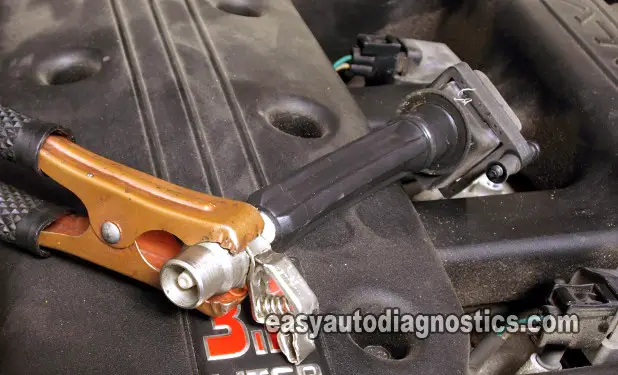Spark Test Basics

The absolutely the best way to test the Coil-On-Plug ignition coil. It's a very easy test, for the majority of vehicles it involves just two steps: 1. Removing the ignition coil but leaving it connected to its connector. 2. Attaching the spark tester. Not just any spark tester. I recommend the HEI spark tester.
You may be wondering why the spark tester is being gripped by a battery jump start cable in the photo above. For the most part, it's because it may not be possible to reach a Grounding point to attach the tester with its own clip. These are the main reasons why:
- Because the boot of the ignition coil may not be long enough.
- The Coil-On-Plug connector may not have enough slack to reach a Grounding point.
- The component is surrounded in plastic, without any Grounding points near.
- The Grounding clip of the tester is not strong enough to stay attached to the Grounding point (if you do find one) as you're cranking the engine.
- The HEI spark tester's clip is very flimsily made and will fall to pieces in a few uses. This is the most common defect of this type of spark tester.
The Most Useless Ignition Coil Test
In my experience, testing the continuity (of the Primary and Secondary circuits with the multimeter in Ohms mode) of the ignition coil has never ever helped me to diagnose a bad ignition coil. But testing them on the car and in action with the HEI spark tester has been THE guaranteed way of finding out if it's good or bad.
Sometimes I've wondered if this testing method (testing the Primary and Secondary resistance) is some sort of cruel joke on the part of the technical writer who wrote the repair manual because of the utter uselessness of this type of test. So, in this article, we won't be exploring this testing method at all.
The Most Effective Way To Test The Ignition Coil
A dynamic spark is the best way to diagnose a bad Coil-On-Plug ignition coil. The spark tester stress-tests the coil and thus you'll get only one of two easy to interpret results: spark or no-spark. The following the spark basics:
- Step One.
- After removing the Coil-On-Plug and attaching the spark tester (if the ignition coil is under the intake manifold plenum, take a look at this section: Ignition Coils Under The Intake Manifold Plenum):
- Have an assistant crank the engine. If you're testing a no-start condition, the engine will not start. If you're testing a misfire, the engine will start.
- After removing the Coil-On-Plug and attaching the spark tester (if the ignition coil is under the intake manifold plenum, take a look at this section: Ignition Coils Under The Intake Manifold Plenum):
- Step Two.
- As the engine is cranking, observe the spark tester. You'll get one of two results:
- Spark.
- No spark.
- As the engine is cranking, observe the spark tester. You'll get one of two results:
- Step Three.
- If you're testing a no-start condition:
- Test several more ignition coils.
- If you're testing a no-start condition:
Analyzing The Results
If you got NO SPARK (misfire condition): Then we need to test the power and Switching circuits at the Coil-On-Plug's connector, before we condemn the ignition coil to the junk heap. Testing of the power circuit has already been covered in the previous page of this article. Testing for the Switching signal will be covered in detail in the next page.
If you got SPARK (misfire condition): Then the power and Switching circuits are doing their job and the ignition coil is working fine. To be absolutely certain that this specific ignition coil is not the cause of the misfire (even after it has passed this performance test) look for carbon tracks on the inside of the coil's boot or on the spark plug. You can find out more about testing for carbon tracks in the following case study article (in this site): Carbon Tracks Are A Common Cause Of Ignition Misfires.
If you got SPARK (no-start condition): at one ignition coil, you'll have test the rest. If all are sparking then the Coil-On-Plug ignition coils and all of their related components and circuits are OK and not the cause of the NO START. You'll have to test the fuel system and the like to find out what the cause is of the no-start.
If you got NO SPARK (no-start condition): You'll have to test at least two more coils or all. And if those other two or all are not sparking and THEY ARE all receiving 12 Volts on their power circuit, the next step is to test for the Switching signal.
Lets turn the page and find out more about this so called 'Switching signal' I'm always harking about.
